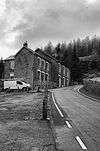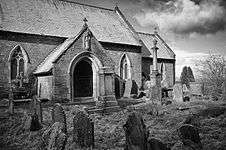Llanwonno
| Llanwonno | |
| Welsh: Llanwynno | |
 Looking down on St Gwynno's Church |
|
 Llanwonno |
|
| OS grid reference | ST029955 |
|---|---|
| Principal area | Rhondda Cynon Taf |
| Ceremonial county | Mid Glamorgan |
| Country | Wales |
| Sovereign state | United Kingdom |
| Post town | Mountain Ash |
| Postcode district | CF45 |
| Dialling code | 01443 |
| Police | South Wales |
| Fire | South Wales |
| Ambulance | Welsh |
| EU Parliament | Wales |
| UK Parliament | Cynon Valley |
| Welsh Assembly | Cynon Valley |
|
|
Coordinates: 51°39′04″N 3°24′11″W / 51.651°N 3.403°W
Llanwonno (Welsh: Llanwynno) is a hamlet high up in the mountains between the historic mining valleys of the Rhondda and Cynon Valleys in Rhondda Cynon Taf deep in the heart of the South Wales Valleys. Llanwonno consists of a church, Eglwys Sant Gwynno and an inn – The Brynffynon Hotel.[1]
Welsh writer and broadcaster Gwyn Thomas immortalised Llanwonno in his 1968 autobiography A Few Selected Exits, in which he recounted how every Sunday he and his father would begin a journey from their home in Porth to visit family in Mountain Ash. They never completed their journey, the pub in Llanwonno being the only place that would serve Gwyn's father on a Sunday. When Gwyn Thomas died in 1981 his ashes were scattered in the churchyard. Later, Llanwonno was used for location filming of the 1993 BBC film adaptation of Thomas' autobiography Selected Exits starring Sir Anthony Hopkins as Thomas.
The church, Eglwys Sant Gwynno, is where legendary athlete Guto Nyth Brân is buried. The story of the life, and death, of Guto Nyth Brân is remembered and celebrated in the centre of the nearby town of Mountain Ash every New Year's Eve, with an event known as the Nos Galan Road Races, in which runners hailing from all parts of the world race through the local streets, with the finishing-line placed at the point of the bronze statue of the legendary figure, which sits in the centre of a public seating area known as 'Guto Square' on Oxford Street.
The ancient parish of Llanwynno (or Llanwonno) included Abercynon, Penrhiwceiber Ynysybwl, most of Mountain Ash/Aberpennar, part of Pontypridd (the area north of the River Rhondda and west of the River Taff), Porth, Stanleytown, Ynyshir, Wattstown and Blaenllechau in the Rhondda. The mountainous area is easily reached on foot or by car, using mountain roads, which lead to Penrhiwceiber, Aberpennar, Ferndale, Ynysybwl, and Pontypridd.
The nearby Llanwynno forestry is the location of the Daerwynno Outdoor Centre, an outdoor pursuits centre run by local people. The centre offers a wide range of activities to visitors, including several training courses for disadvantaged young people.
A Victorian history of the parish, Glanffrwd's History of Llanwonno 1843–90, was published by the Rev. W. Thomas in 1888 in serial form in the Darian.[2] A revised edition in the new spelling by Prof Henry Lewis for the University of Wales Press appeared in 1949.[3]
The exterior scenes of the Doctor Who television episode The Hungry Earth (BBC, 2010) were shot in Llanwynno.[4]
Gallery




References
| Wikimedia Commons has media related to Llanwynno. |
- ↑ "The Brynffynon Hotel". Retrieved 2 June 2015.
- ↑ "Glanffrwd's History of Llanwonno, 1843-90 (Hanes Plwyf Llanwonno)". genuki.org.uk. Retrieved 1 April 2012.
- ↑ Glanffrwd (1949). Lewis, Henry, ed. Llanwynno. Cardiff: Gwasg Prifysgol Cymru (University of Wales Press).
- ↑ "The Forth Dimension - The Hungry Earth". BBC. Retrieved 2 June 2015.